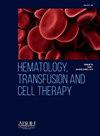AUTOIMMUNE ENCEPHALITIS AND PARANEOPLASTIC SYNDROMES: A CLINICAL AND FDG-PET/CT STUDY
IF 1.8
Q3 HEMATOLOGY
引用次数: 0
Abstract
Introduction/Justification
Autoimmune encephalitis (AE) is a debilitating neurological disorder characterized by inflammation of brain tissue. Frequently, it is associated with the detection of highly specific antibodies, as such as NMDA, Yo, GAD, Hu, among others. Oftentimes, this condition is expressed as a paraneoplastic syndrome (PNS), for which the neurological manifestation precedes the tumor diagnosis up to 4 years in about two-thirds of the patients.
Objectives
This work applied the review of clinical findings and FDG-PET/CT images analysis to characterize and explore the outcomes of patients diagnosed with AE, both clinically and by antibodies test.
Materials and Methods
The study includes 37 patients, aged from 13 to 75 (47.08 ± 20,00 years), 65% female, who had been presented neurological manifestations of encephalitis and PNS. The group of patients was divided according to the antibodies detected (NMDA, Yo, Hu, LGI1, GAD, Amphiphysin, Aquaporin-4), being also studied a group of patients with negative antibodies and untested. Retrospectively, the clinical records were analyzed by the neurology staff, being the clinical manifestations and the results of antibodies tests correlated with FDG-PET/CT brain images, analyzed by an expert in nuclear medicine.
Results
Among the groups studied, 24.3% had suspicion or confirmed neoplasia (most of them breast or thyroid lesions), being 49% of the patients positive for antibodies related autoimmune encephalitis (AE). In the pretreatment phase, patients with Yo antibodies, manifested epilepsy and cerebellar ataxia, with FDG-PET/CT revealing hypermetabolism in the basal ganglia, cingulate gyri, thalamus, and midbrain, with hypometabolism in the cerebellar hemispheres. Hu antibodies has been associated with epilepsy, sensitive and behavior alterations, being the hypermetabolism in the cingulate gyrus and hypometabolism in the cerebellar hemispheres identified in the PET/CT images; on the other side, GAD antibodies resulted in higher FDG uptake in the thalamus and midbrain, with hypometabolism in the frontal lobes. In this case, the neurological manifestations include epilepsy, ataxia with aspects of stiff-person syndrome, behavior and sensitive alterations. Most of the clinical manifestations mentioned has also been observed in patients with NMDA antibodies, who expressed cingulate gyri, precuneus, parietal lobes and basal ganglia hypermetabolism, and cingulate hypermetabolism, with cerebellar hemispheres hypometabolism, characterizing an anteroposterior gradient of FDG uptake. LGI1 antibodies resulted in hypermetabolism in the basal ganglia and temporal mesial lobe, with frontal hypometabolism. For most of the groups of patients, epilepsy was a common manifestation, followed by behavior and sensitive alterations. The exception is the aquaporin-4 antibody for which muscular disorders are the main symptom, also highlighted in GAD patients.
Conclusion
PET/CT FDG is able to detect metabolic alterations in brain images with a high sensitivity. Different anti-bodies can show different patterns of hypermetabolism and hypometabolism. More studies with higher casuistic are necessary to better identify each pattern. Moreover, PET/CT FDG with whole body studies is able to detect neoplasm or suspicious neoplasm lesions.
求助全文
约1分钟内获得全文
求助全文
来源期刊

Hematology, Transfusion and Cell Therapy
Multiple-
CiteScore
2.40
自引率
4.80%
发文量
1419
审稿时长
30 weeks
 求助内容:
求助内容: 应助结果提醒方式:
应助结果提醒方式:


